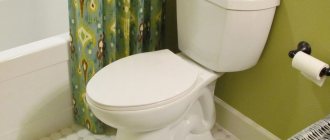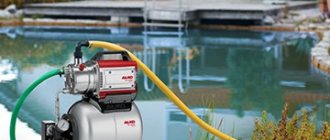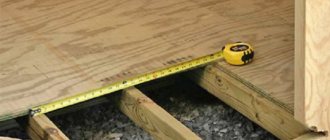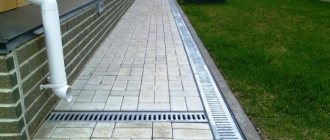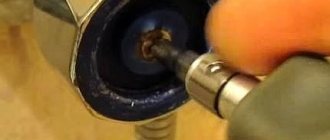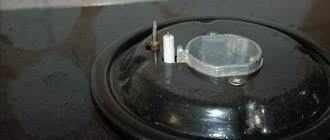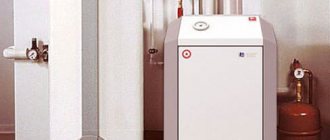Any sewer system is a complex structure consisting of multiple pipes, as well as devices with drains. All kinds of malfunctions in its functioning (squelching or gurgling sounds, unpleasant odors) greatly bother residents and serve as an alarming signal. To solve this problem, you need to understand the true reasons for its occurrence, then take appropriate corrective measures.
The functioning of the sewerage system largely depends on the correctness of its installation and compliance with all technical requirements Source gidkanal.ru
Causes of sounds
To understand why the sewer gurgles in the bathroom, it is recommended to familiarize yourself in detail with its design. As a rule, sewage system pipelines are located at a slight slope. In addition, they are connected to a vertical section, in other words, a riser.
During the draining process, water acts like a piston: it creates a certain pressure on the air layers below, and a vacuum in the uppermost levels. Since the resulting piston is not rigid, gases can easily overcome it. They penetrate the water plug, gradually accumulate in the upper part of the pipe, and then begin to affect the hydraulic valves of the plumbing. In some cases, the opposite process occurs: the moving water plug moves (pushes) air. Due to the latter, a strong vacuum is created in areas that are too close to the outlets of the devices.
Vacuum in the pipes due to improper sewerage installation in the house often leads to water being sucked out of the siphons and the appearance of an odor in the house Source san-kras.ru
When the impact becomes significant, the hydraulic valve breaks down or is internally retracted. In any case, a characteristic sound is heard. It is often perceived by residents as if a sewer gurgles in a private house.
Some experts believe that the real root cause of the periodic appearance of alarming sounds is hidden in blockages. In fact, this statement is controversial, since the speed of movement of wastewater under such circumstances rapidly decreases, the air pressure equalizes gradually, completely silently.
In the mechanical method of sewer cleaning, a spiral equipped with a special nozzle is inserted into the sewer pipeline. Source torufix.ee
Methods for eliminating leaks
As a rule, repairing a siphon is not a difficult task. And the materials necessary for this can be found in the pantry of almost any home. Below are some recommendations on what to do if the siphon is leaking.
Required Tools
Plastic siphons can be disassembled by hand, so no special tools are needed. Although in some cases a screwdriver, a cable for cleaning drain pipes may still be useful (a metal brush with a long handle or even an ordinary wire brush will also work), and it is advisable to stock up on a rag and a container for water. To restore the tightness of spare parts and their joints, silicone glue or sealant, a “liquid nails” type composition, and sometimes even a regular medical bandage are useful.
Siphon leaks can be eliminated using “liquid nails”
If you have to disassemble a metal siphon, especially one that has been in use for a long time, you may need tools such as a grinder and a drill. With their power, it will be possible to disassemble the siphon by sawing off the caps of the bolts, and then drilling out what is left. In order not to damage the metal siphon during disassembly, it is recommended to use power tools.
Restoring the tightness of gaskets
Abrasion or other changes in the condition of the gaskets can cause the siphon to begin to leak. Rubber parts that have hardened during use are best replaced. Usually they are available in any specialty store. In order for the purchased parts to last longer, they are lubricated with liquid soap or Vaseline, which facilitates the installation process.
However, there is not always the desire or opportunity to purchase new gaskets. In this case, you can try to restore the old ones. To restore them, they must be lubricated with silicone glue, sealant, or a compound called liquid nails, and then put in place. When the applied composition dries, the plumbing fixtures can be used. This measure will extend the life of the rubber gaskets for several more years.
Repairing cracks
If the pipe is cracked at the seam, then repairing it is quite simple. To begin with, the split site is cleaned with sandpaper and then lubricated with pre-diluted epoxy glue. If desired, dyes can be added to the composition used.
To repair cracks you will need epoxy glue
When the surface is lubricated, it is wrapped with a medical bandage. This event is performed two or three times. This creates several layers of epoxy glue and bandages on the pipe. The drying time for this design is about six hours. After drying, the siphon can be put back in place and the plumbing can be used. A pipe reinforced in this way becomes much stronger than the one originally purchased.
Sealing connections
Sealing of connections may be necessary due to manufacturing defects or during operation. Sometimes it becomes necessary to additionally seal the joints of the siphon parts. For example, a worn thread prevents the rubber gasket from being pressed tightly against the hole. In this case, tow or silicone tape is used for compaction. It is important to remove excess sealant after securing the nut. In some cases, if the thread is seriously damaged, cold welding can be used, however, this will extend the service life for only a short time, since the fragile plastic will soon continue to crumble. In this case, it is better to take care of purchasing a new siphon.
Biogas pressure
Sometimes owners install independent drainage systems with their own hands. But in order to ensure the proper functioning of the septic tank, certain knowledge is required. Due to their absence, the container sometimes turns out to be hermetically sealed, devoid of ventilation. As a result of waste decomposition, biogas is released, which subsequently creates pressure inside the pipeline network. It begins to negatively affect plumbing siphons.
After draining the water, the volume of the latter increases, and at the same time gas accumulations are displaced. As a result, the pressure inside the system increases, a certain amount of gas overcomes the hydraulic seal and comes out. For this reason, the sewage system gurgles in the bathroom or other plumbing fixtures, since their constituent elements could not resist the gas pressure. This process usually results in the appearance of an unpleasant odor. The described problem can be eliminated using technical methods.
A water seal is a curved pipe that holds water, preventing the penetration of gases from the sewer network into the room Source remoo.ru
It happens that the drain sloshes loudly in the sink or bathtub even without draining. At such a moment, the volume of accumulated gases exceeds the permissible limits, and some of them penetrate through the water layer. This often happens in devices with small outlets, which are not always able to provide the necessary resistance. For example, modern plastic water seals designed for bathtubs have a small drop. It is easily overcome even by slight pressure of waste gases.
The main problem in the situations described is incorrect assembly of the system. The real root cause why the toilet gurgles in the bathroom when flushed is hidden in the complete tightness of the pipelines, as well as the lack of ventilation. As a rule, such a technical miscalculation is allowed at the stage of creating a project or during installation work.
As soon as it becomes obvious that the sink or toilet is “squelching”, you must immediately call a specialist Source i.ytimg.com
Siphon replacement
The process of replacing a siphon under a sink consists of the following steps:
- Removing the old drain. The work is done over a bucket. A rag is prepared in advance and should be used to immediately cover the hole in the sewer pipe to avoid an unpleasant odor.
- After dismantling, any remaining contaminants are removed and the sewer pipe is cleaned.
- Threaded connections on the siphon body are checked for burrs. If there are any, they are carefully cut off with a knife. You also need to make sure that all gaskets are in place.
- The sink drain grate is lined and installed with a gasket or sealant to prevent leakage.
- A thick gasket is placed on the outlet of the sink, after which it is placed at the bottom center of the sink drain hole. A screw is inserted into the central hole and screwed with a screwdriver so that the drain grid and outlet are pressed tightly against the sink.
- The flask of the device is assembled. A rubber gasket should be installed on the bottom and the cover should be screwed on. A union nut and a cone-shaped gasket are put on the outlet of the sink. The upper part of the siphon is placed on it, after which the outlet union nut is screwed to it. Such a connection is reliable and airtight. It is often used in non-pressure systems. An exhaust pipe is connected to the flask.
Siphon designs may vary. The assembly procedure for each of them is indicated in the attached instructions. The diagram of the classic device is in this article.
- The sewer pipe should be dried and a cuff lubricated with sealant should be installed in it.
- The drain end of the outlet pipe is adjusted to size, then inserted into the sewer pipe, where it is sealed with a cuff.
- Water is supplied to the sink for some time to check the tightness of the connections.
This instruction describes the installation of a bottle siphon. A pipe-type drain device is even easier to install since there is no need to assemble the flask. The corrugated device must be curved in the shape of the letter “S” and secured using the clamp included in the kit.
What does biogas consist of?
Most of the sewer system is an empty pipeline system. Inside it, any gases move easily and freely occupy the available volume. In private buildings, such independent structures are connected to settling tanks and special waste containers. Fermentation occurs there, the gradual decomposition of organic substances. With an excessive increase in gas volumes, the pressure in the entire sewer network rapidly increases. If it exceeds the permissible value, then gas enters the home. As a rule, this manifests itself in the same way: an unpleasant odor from the toilet, sink or bathtub, as well as gurgling sounds in the hydraulic valve.
The composition of biogas includes: methane, carbon dioxide, impurities of hydrogen sulfide, ammonia, nitrogen oxides, and other compounds. The first component occupies approximately 63% of the total volume, the rest are significantly less. Moreover, some of the latter are more harmful to health.
Biogas is formed during anaerobic (without air) methane fermentation of biomass Source strojdvor.ru
Prevention of unpleasant odor
Preventing stink is always more effective than getting rid of it. Prevention measures include:
- regular checking and cleaning of ventilation ducts, maintenance of electric fans in good condition;
- use of high-quality plumbing and sewer pipes;
- maintaining technology when connecting collectors, carefully sealing the connections;
- Meshes are placed on drains to trap small debris and hair so that they do not fall into the sewer.
It is better to invite craftsmen to lay communications. If you do it yourself, you need to study the installation rules and get competent instructions.
Why is it dangerous for humans?
As a result of excessive accumulation of biogas inside the sewer system, the following serious consequences are possible:
- Poisoning. Nausea, dizziness, low performance, severe fatigue, and inattention are observed.
- Sudden ignition. When the gas reaches a high concentration, there is a risk of explosion.
- Distribution of infectious agents of various diseases. The most dangerous among them today are considered to be: dysentery, tuberculosis, and polio.
It is important to remember: the percentage of gas components changes periodically, for the most part it depends on the stock volumes and the composition of organic matter. Therefore, it is almost impossible to foresee the consequences of inhaling gas accumulations. Biogas should not be allowed to enter living rooms in order to prevent harmful effects on the human body. When a toilet gurgles in a home, this portends the entry of dangerous gas components from the pipeline system into the premises. It is unacceptable to ignore such an alarming signal; we urgently need to address the emerging complexity.
A well-functioning sewer system never attracts attention: water leaves through the drain, then enters the riser, through which it is sent to the collector Source kanaliza.ru
Baking soda, vinegar and lemon are useful for more than just lemon pie
Those who don’t like radical chemicals can always turn to homemade sink cleaning recipes. You can break through a cork using various substances that any housewife can find.
There is an opinion that keeping your apartment clean can be done by having a sponge, baking soda, lemon (citric acid) and vinegar on hand.
Mirrors and windows are rinsed with a vinegar solution; it has dust-repellent properties and does not leave streaks. Citric acid removes scale from teapots one-two-three times. Use baking soda to make your kitchenware shine. The list goes on for a long time. But let's turn to our problem - there is a blockage in the sink.
To remove a garbage plug, try any of the effective recipes below.
Soda and vinegar
Take 200 g of soda, pour it into the sink drain, add 250 ml of 9% vinegar, close the hole tightly. A rather caustic foam is formed, which will cope with the problem.
After half an hour, turn on the hot water, skip a few minutes to achieve perfect cleanliness of all elements of the sewer system. Cleaning should be done with the windows open.
Lemon acid
Take 100 g of citric acid, pour it into the sink drain, add a glass of boiling water, and close with a stopper. After half an hour, run hot water for a few minutes.
Alka-Seltzer
An original way to clean the sink siphon is to use a home first aid kit. Alka-Seltzer is perfect for solving our problem. Place 2-3 tablets in the drain, pour in 250 ml of 9% vinegar, close the drain hole. After a few minutes, run hot water.
In conclusion, let's talk about preventing a clogged kitchen sink, because many problems will not become so if we do not allow it ourselves.
Video description
Fan riser device.
Ventilation valve
A valve is used to compensate for insufficient or excess pressure in the waste system. Typically, completely enclosed structures are installed inside private buildings. The latter do not allow gas to penetrate into the home; they open only when a vacuum occurs. In the meantime, a sufficient amount of air enters the pipes, and the likelihood of hydraulic valves breaking disappears.
There are valves that allow air masses to enter the system and also release excess air to the outside. Such structures are installed exclusively in the attic: the outlet pipe is connected to the pipeline in order to remove gases outside the attic.
Attention! Valves are used only when it is completely impossible to use a drain pipe. This is due to their lower efficiency and high risk of failure.
An aerator (air valve) is a small round device that is mounted on a sewer pipe in a vertical position Source i.ytimg.com
Useful tips
The following tips will help you operate the drainage device without any problems:
- When installing a siphon, it is necessary to ensure that the drain grate is symmetrically positioned relative to the sink opening.
- The device is cleaned by supplying hot water, which dissolves fat deposits well. To speed up the process, use soda or special detergents. They are poured into the hole, and then the water is intensively drained, washing.
- The use of a plunger allows you to periodically clean the device without disassembling the sump.
- Thread sealing does not ensure tight connections. Rubber gaskets provide reliable protection against leaks. When worn, they should be replaced.
- It is not recommended to pour overly contaminated liquids into the sink. A fine strainer is installed at the outlet, which should be cleaned periodically.
Precautionary measures
Fecal water and sludge are very toxic and chemically aggressive substances; Sewer gases are also explosive. The danger is compounded by the fact that toxic substances can enter the body through intact skin.
Mains plumbers are well aware of this and do not neglect safety precautions.
Domestic plumbers rarely have to deal with large masses of toxic substances or gas emissions from a pipe, but in each such case the consequences are severe precisely because of the neglect of safety precautions
Apartment residents have nothing to fear: the water seal in the siphon elbow reliably locks the pipe outlet. But when replacing the siphon, its pipe will be open, and you will have to work with your hands in the immediate vicinity of the sludge deposits and clean it off. Therefore, stock up on latex gloves, a plastic apron and a petal respirator. If suddenly you experience that same 1 in 10,000 cases, it will do no harm.
How to choose?
When purchasing a device, you must take into account the fact that a kitchen siphon cannot be installed in a bathroom. The wrong choice of plumbing parts will cause difficulties in using the drainage system.
Signs of a quality siphon:
- availability of certificates and permits;
- strict compliance with the type of sink and its individual characteristics;
- simplicity of design;
- availability of a complete set of parts;
- material of manufacture – plastic, stainless steel and brass;
- reasonable and adequate price;
- absence of mechanical damage and smooth surface;
- availability of high-quality threaded connections.
Modern technologies make it possible to independently cope with any type of household breakdown. Repairing and replacing a siphon is a simple process that can be carried out even by inexperienced craftsmen. Experts recommend not to wait for the device to become completely clogged, cracks to appear, or an unpleasant odor to appear. If the structure is leaking, appropriate measures must be taken immediately. Carrying out preventive measures will help to avoid problematic issues and significantly save the financial costs of purchasing a new siphon.
Use of household chemicals
Many housewives, when a smell appears from the sink, begin to actively look for a product that, when poured into the pipeline, will eliminate the nuisance. All compositions that are used for cleaning pipes can be divided into 2 groups:
- Industrial;
- Household.
Variety of household chemicals
The first ones are those produced by the chemical industry. These products are developed by chemical scientists to get rid of organic blockages in pipes. The most famous representatives of this group are the following brands:
- "Mole";
- "Rowdy";
- "Odorgon";
- "Domestos" and others.
Household products are called improvised compounds that are most often found in every home. The smell from the kitchen sink can be eliminated with mustard powder, table salt, soda ash or baking soda diluted with vinegar. All these products are poured into the sink and filled with water, after which the pipes are not used for some time.
Basic means of dealing with blockages
It is worth noting that inorganic pollution cannot be eliminated using household chemicals. It's just a transfer of money and time. This fact is not mentioned either in advertising on TV or in the instructions for the drugs themselves.
Sealing a pipe in a toilet
A leak in a pipe can also be eliminated with an adhesive bandage.
The procedure in this case is as follows:
When using fiberglass, the cut piece should be enough to wrap the pipe at least 5-6 times. The width of the bandage should exceed the diameter of the pipe by at least one and a half times. It is more convenient to apply glue to the bandage with a brush or spatula.
After wrapping the bandage fabric around the pipeline, it is secured with a tie or clamp until it dries completely. The glue usually dries within 24-72 hours. The air temperature must be at least + 15 degrees.
Required Preparation and Tools
To fix a leak, you will need the following tools and materials:
- an adjustable wrench for loosening tight connections;
- new siphon or fittings;
- clamp;
- degreaser (white spirit, or nefras);
- sealant, if necessary - epoxy glue, cold welding;
- plumber's tape or tow (for leaking metal threads);
- liquid soap for lubricating gaskets;
- a bucket and dry rags to collect liquid.
To replace the section, you will need a grinder or a metal saw, a coupling and a new pipe 40-50 cm longer than the cut one.
Before you begin the repair, you need to perform several steps:
- Determine the location of the leak and, if possible, determine the cause of its occurrence. This will prevent problems during subsequent use.
- Shut off the water supply. If a leak is observed at the point of supply to the plumbing, then you can turn off the valve in 1 area. Otherwise, you will have to turn off the water in the apartment or throughout the riser. In the presence of cold water and domestic hot water, both supply valves are closed.
- If you couldn’t quickly turn off the water, wrap a section of pipe with a rag and lower its end into a wide basin. It is possible to repair a leak without draining the water only if the cause is minor corrosion damage.
- Disassemble the connection if necessary for repairs. Clean the siphon and adjacent pipes.
- If connections leak, check the threads and nut for cracks and replace the rubber gasket.
- Dry and degrease the repair area. Dirt and grease impair the adhesion of sealants, so the new connection will not be strong. When assembling plastic parts, do not use strong solvents, acids or acetone.
If the location of the damage is close to the common apartment valve (for example, near the meter), then after shutting off the hot water supply and hot water supply, you need to check whether the leak has stopped.
If liquid continues to collect on the pipe, then the entire riser must be disconnected for repair.
Fault diagnosis
The very first thing that catches your eye is always a blockage. You turn on the tap, and the water, instead of going down the drain, comes back. If there is no blockage, just inspect the siphon from all sides (yes, this is poetry). This way you can see cracks or chips. If nothing of the kind is found, all that remains is to disassemble the siphon.
During the analysis, you will notice all the installation flaws, if any. If everything is in order here, the last thing left is to check the gasket. It should fit correctly, be soft and flexible, and not have cracks.
They did all this and everything is ok? Put it back together and the leak is still there? Let a professional plumber help you!
